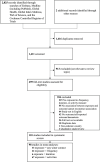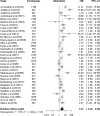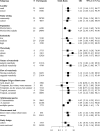Associations of water contact frequency, duration, and activities with schistosome infection risk: A systematic review and meta-analysis
- PMID: 37315020
- PMCID: PMC10266691
- DOI: 10.1371/journal.pntd.0011377
Associations of water contact frequency, duration, and activities with schistosome infection risk: A systematic review and meta-analysis
Abstract
Background: Schistosomiasis is a water-borne parasitic disease which affects over 230 million people globally. The relationship between contact with open freshwater bodies and the likelihood of schistosome infection remains poorly quantified despite its importance for understanding transmission and parametrising transmission models.
Methods: We conducted a systematic review to estimate the average effect of water contact duration, frequency, and activities on schistosome infection likelihood. We searched Embase, MEDLINE (including PubMed), Global Health, Global Index Medicus, Web of Science, and the Cochrane Central Register of Controlled Trials from inception until May 13, 2022. Observational and interventional studies reporting odds ratios (OR), hazard ratios (HR), or sufficient information to reconstruct effect sizes on individual-level associations between water contact and infection with any Schistosoma species were eligible for inclusion. Random-effects meta-analysis with inverse variance weighting was used to calculate pooled ORs and 95% confidence intervals (CIs).
Results: We screened 1,411 studies and included 101 studies which represented 192,691 participants across Africa, Asia, and South America. Included studies mostly reported on water contact activities (69%; 70/101) and having any water contact (33%; 33/101). Ninety-six percent of studies (97/101) used surveys to measure exposure. A meta-analysis of 33 studies showed that individuals with water contact were 3.14 times more likely to be infected (OR 3.14; 95% CI: 2.08-4.75) when compared to individuals with no water contact. Subgroup analyses showed that the positive association of water contact with infection was significantly weaker in children compared to studies which included adults and children (OR 1.67; 95% CI: 1.04-2.69 vs. OR 4.24; 95% CI: 2.59-6.97). An association of water contact with infection was only found in communities with ≥10% schistosome prevalence. Overall heterogeneity was substantial (I2 = 93%) and remained high across all subgroups, except in direct observation studies (I2 range = 44%-98%). We did not find that occupational water contact such as fishing and agriculture (OR 2.57; 95% CI: 1.89-3.51) conferred a significantly higher risk of schistosome infection compared to recreational water contact (OR 2.13; 95% CI: 1.75-2.60) or domestic water contact (OR 1.91; 95% CI: 1.47-2.48). Higher duration or frequency of water contact did not significantly modify infection likelihood. Study quality across analyses was largely moderate or poor.
Conclusions: Any current water contact was robustly associated with schistosome infection status, and this relationship held across adults and children, and schistosomiasis-endemic areas with prevalence greater than 10%. Substantial gaps remain in published studies for understanding interactions of water contact with age and gender, and the influence of these interactions for infection likelihood. As such, more empirical studies are needed to accurately parametrise exposure in transmission models. Our results imply the need for population-wide treatment and prevention strategies in endemic settings as exposure within these communities was not confined to currently prioritised high-risk groups such as fishing populations.
Copyright: © 2023 Reitzug et al. This is an open access article distributed under the terms of the Creative Commons Attribution License, which permits unrestricted use, distribution, and reproduction in any medium, provided the original author and source are credited.
Conflict of interest statement
The authors have declared that no competing interests exist.
Figures








References
-
- World Health Organization. World Health Assembly Resolution WHA 66.12 Neglected tropical diseases. Geneva: World Health Organization; 2013.
Publication types
MeSH terms
Grants and funding
LinkOut - more resources
Full Text Sources
Research Materials

